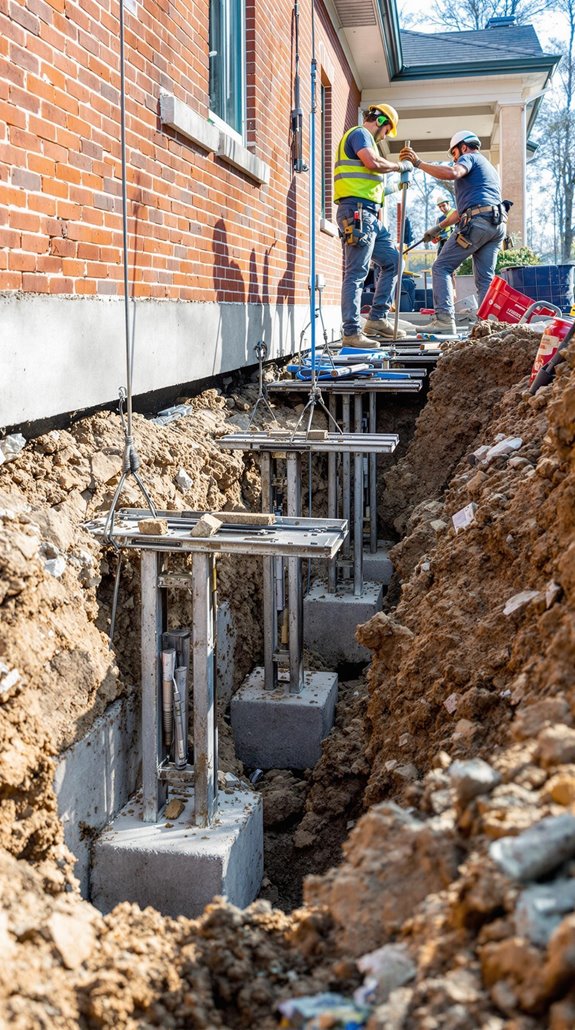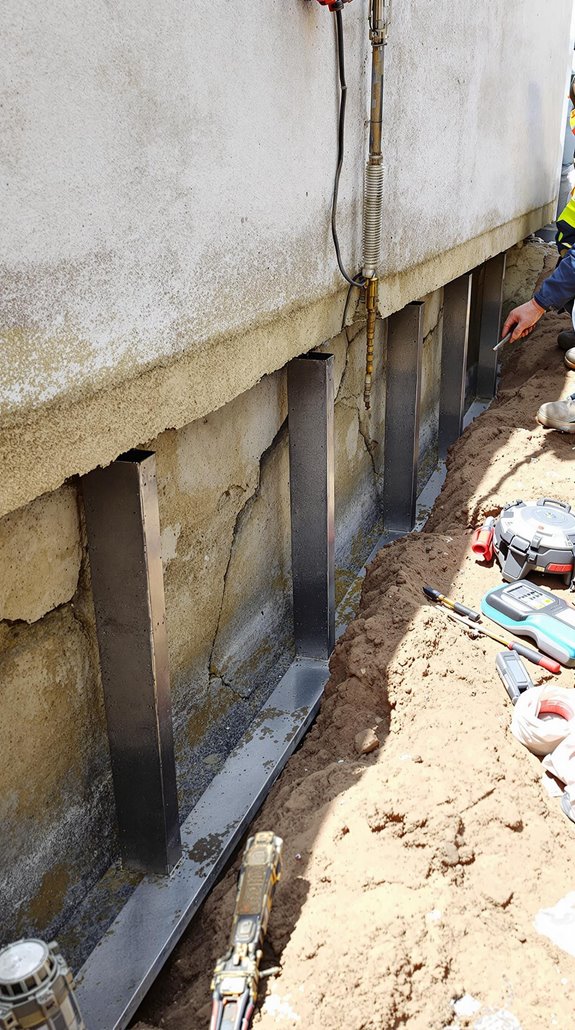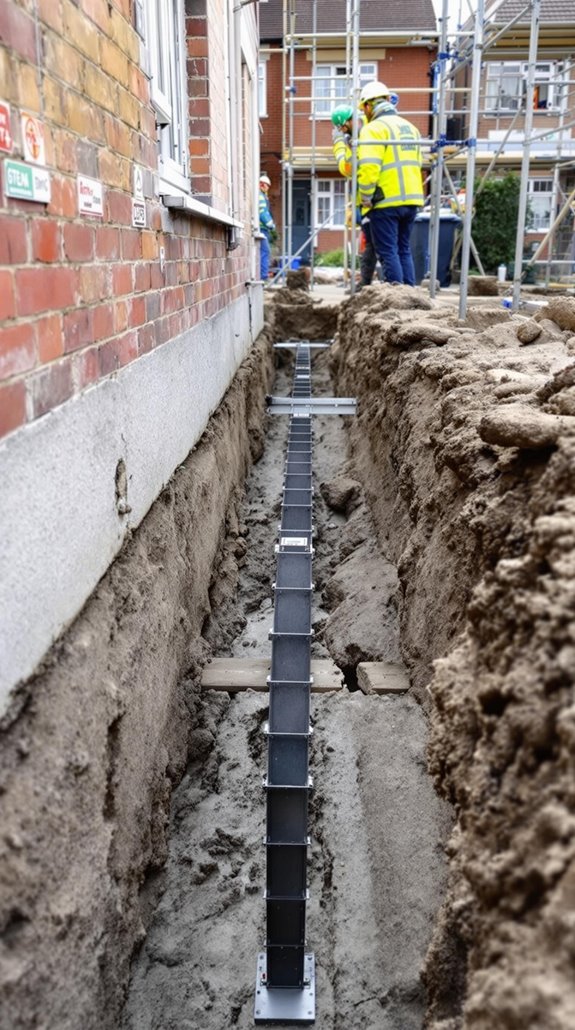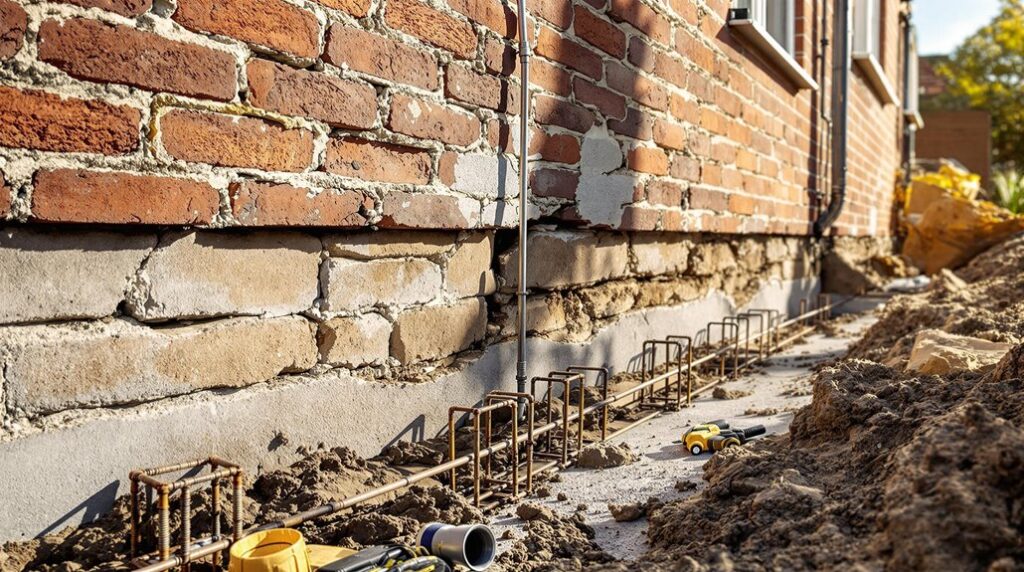I’ve seen countless homeowners panic when they discover foundation issues, but here’s what you need to know: underpinning costs in the UK typically range from £6,000 to £21,000, depending on your property’s specific requirements. The method you’ll need—whether it’s mass concrete, beam and base, or resin injection—directly impacts your final bill. Before you start gathering quotes, there are several critical factors that’ll determine whether you’re looking at the lower or higher end of this spectrum.
Key Takeaways
- UK underpinning costs average £13,500 nationally, ranging from £6,000 to £21,000 depending on method and location.
- Mass concrete underpinning costs £1,200-£2,500 per square metre, while resin injection is most economical at £500-£1,000.
- London and South East regions command premium rates, with mass concrete underpinning costing £1,800 per square metre.
- Soil conditions, depth to stable layers, and site accessibility significantly influence final underpinning project costs.
- Building regulations approval and insurance declaration are mandatory before starting any underpinning work on UK properties.
What Is Underpinning and When Do You Need It?

Foundation problems don’t announce themselves with fanfare—they creep up through hairline cracks that widen into structural threats. I’ll help you understand when underpinning becomes your lifeline.
Underpinning strengthens existing foundations by extending their depth or breadth to reach stable soil layers. It’s your solution when original foundations can’t handle current loads or environmental pressures. Understanding the potential renovation costs involved is crucial for effective budgeting.
You’ll need underpinning when you spot diagonal cracks exceeding 3mm, doors sticking from frame distortion, or floors separating from walls. Soil subsidence, nearby construction excavations, or building extensions often trigger these issues. Buildings over 40 years old with shallow strip foundations commonly require mass concrete underpinning methods.
I recommend mass concrete underpinning for straightforward cases, while resin injection works for soil stabilization. Don’t wait—foundation damage accelerates rapidly, and early intervention saves both money and structural integrity.
UK Average Underpinning Costs and Price Ranges
Most UK homeowners face underpinning costs between £6,000 and £21,000, with the national average settling at £13,500. I’ll break down what you’re looking at per square metre: mass concrete runs £1,500, beam and base hits £2,000, mini-piling reaches £2,600, and resin injection costs £1,200.
Your location greatly impacts pricing. If you’re in London or the South East, expect premium rates—mass concrete jumps to £1,800 per square metre, while mini-piling climbs to £3,200. That’s a substantial 20% increase over national averages.
Most projects span 3-5 weeks, though your timeline depends on damage severity and chosen method. Remember, conservation areas or listed building status can push costs higher due to additional regulatory requirements. You’ll also need to budget for a structural engineer assessment, which typically costs £500-£1,000 for a full evaluation.
Underpinning Methods and Their Cost Per Square Metre
Now that you understand the financial landscape, let’s examine each underpinning method and its specific cost implications.
Mass concrete underpinning costs £1,200–£2,500 per square metre, making it suitable for shallow foundations with stable soil conditions. You’ll need adequate structural strength to span excavation pits during sequential work.
Beam and base underpinning runs £1,500–£2,500 per square metre, offering reduced excavation volume and anti-heave measures for clay soils. This method redirects loads through reinforced concrete beams to strategic mass concrete bases.
Piled underpinning methods cost £1,500–£2,500 per square metre, transferring loads to deeper stable strata with minimal ground disturbance. This technique proves essential when firm soil layers are located deep underground.
Resin injection underpinning offers the most economical solution at £500–£1,000 per square metre, perfect for localised subsidence issues.
Angle piling technique costs £1,300–£2,200 per square metre, reducing excavation by 60%.
Key Factors That Affect Your Underpinning Budget
Understanding your project’s scope requires examining the variables that can dramatically shift costs from budget-friendly to substantial investment. Your soil conditions present the primary challenge – clay soils demand costly underpinning solutions, while waterlogged earth requires additional measures that increase expenses. The depth to your stable layer directly impacts piling costs, requiring more materials and labour for deeper foundations. Early detection of subsidence issues is crucial to avoid escalating repair costs.
Site accessibility becomes essential when you’re working in tight spaces between buildings or urban locations like London, where restricted access necessitates manual labour and specialist equipment. Properties built on slopes will cost you more due to complex engineering requirements.
Your property’s size and structural complexity determine the project’s scale, while local regulations and permit requirements add administrative costs that can’t be overlooked in your planning process. The underpinning method you choose will significantly affect your overall budget, with mass concrete being the most economical option and piling systems commanding premium prices.
Regional Price Variations Across the UK
Your underpinning costs will vary considerably based on your property’s location across the UK. I’ve analyzed current pricing data to show you exactly what you’ll pay in different regions.
London and South East commands the highest prices: mass concrete at £1,800 per m², mini-piling at £3,200 per m², and resin injection at £1,400 per m². Urban density drives these premium rates.
Midlands offers moderate pricing: mass concrete £1,500 per m², mini-piling £2,600 per m², resin injection £1,200 per m².
North England provides better value: mass concrete £1,300 per m², mini-piling £2,200 per m², resin injection £1,000 per m².
Scotland and Wales deliver the most competitive rates: mass concrete £1,200 per m², mini-piling £2,000 per m², resin injection £900 per m². Local soil conditions can significantly affect both the complexity and final pricing of your underpinning project.
This regional variation can impact your total project budget by 30-40%.
Timeline and Process for Underpinning Projects
Foundation underpinning projects follow a structured five-phase process that typically spans 4-8 weeks, depending on your property’s size and the chosen method.
I’ll walk you through each critical phase. First, you’ll need structural assessment and design approval, requiring soil analysis and method selection. Next comes regulatory compliance – building control applications and Party Wall notices if you’re near neighbours. The preparation phase involves installing temporary supports and excavating trial pits to confirm ground conditions.
During execution, we excavate in controlled 1.2-1.5m stages, pouring concrete pins sequentially to avoid undermining existing foundations. Mass concrete underpinning progresses systematically, with each section curing before advancing. Multiple reinforcement bars are driven into the sides of each pin before concrete is poured to provide structural integrity.
Finally, completion involves removing temporary supports, conducting building control inspections, and obtaining your completion certificate for regulatory compliance.
Insurance Coverage for Foundation Underpinning

When you’re dealing with an underpinned property, securing adequate insurance becomes considerably more complex and expensive than standard home coverage. You’ll need specialized policies from providers like Homeprotect or Intelligent Insurance, as standard insurers often decline underpinned homes entirely.
Expect higher premiums, especially for recent underpinning work. Your excess for subsidence claims will likely increase greatly. You must declare all underpinning work and past subsidence issues when applying – failure to disclose can invalidate your policy completely.
Coverage typically includes buildings insurance up to £1 million, contents protection, and alternative accommodation if your home becomes uninhabitable. You’ll need a Certificate of Structural Adequacy to prove stability and potentially reduce costs. Remember, non-disclosure by sellers opens legal action possibilities.
The insurance process involves completing an online quote where in-house underwriters assess your specific situation and typically provide a tailored policy within a couple of days.
Getting Quotes and Choosing the Right Specialist
How do you identify a qualified underpinning specialist among contractors who may lack the specialized expertise this critical structural work demands?
I’ll guide you through my proven verification process. First, confirm they’re ASUC members with structural engineering credentials and underpinning-specific certifications. Review their case histories showing comparable project completions, especially with historic buildings if applicable.
When evaluating quotes, demand fully itemized breakdowns covering materials, labor, and monitoring equipment. Require detailed methodology statements explaining excavation sequences and temporary support systems. I reject any proposals suggesting bay lengths exceeding 1.5m without specialist justification.
Insist on thorough ground investigation reports and structural monitoring plans. Prioritize contractors demonstrating “golden rules” compliance in previous projects. Verify they include granular backfill specifications and contingency protocols for adjacent structure protection.
Remember that underpinning work on historic buildings carries significantly higher risks than ordinary buildings, so selecting contractors with specific conservation experience becomes absolutely essential for protecting irreplaceable architectural heritage.
Building Regulations and Compliance Requirements

Unless you secure proper building regulations approval before starting underpinning work, you’re breaking the law and risking serious consequences. I’ll help you navigate this critical requirement so you don’t face fines up to £5,000 or enforcement actions.
You must submit your application to the local building control authority before commencing work. Include structural design specifications and methodology descriptions with your submission. Don’t skip this step – underpinning is classified as “building work” requiring mandatory approval.
You’ll also need CDM Regulations 2015 compliance, including risk assessments and method statements. If you’re working near neighbouring properties, the Party Wall Act 1996 applies, requiring legal agreements with adjacent owners. These regulations ensure structural stability and protect occupants from hazards related to poor construction practices. Additionally, maintaining clear records of all your renovation activities can help in discussions with planning officials if any issues arise.
Conclusion
I’ve covered the essential cost factors and technical considerations for underpinning your UK property. Don’t delay addressing foundation issues—they’ll only worsen and become more expensive. Get multiple quotes from certified specialists, verify their building regulations compliance, and check your insurance coverage before starting. With costs averaging £13,500, it’s a significant investment that’ll protect your home’s structural integrity and value. Act now to prevent catastrophic foundation failure and guarantee your property’s long-term stability.
References
- https://zapperty.com/blog/how-much-does-it-cost-to-underpin-house
- https://www.myjobquote.co.uk/costs/underpinning-a-house
- https://www.checkatrade.com/blog/cost-guides/underpinning-costs/
- https://blog.planna.co/cost_guides/costs-of-underpinning-a-house/
- https://mainmark.com/uk/subsidence-advice/how-much-does-underpinning-cost/
- https://en.wikipedia.org/wiki/Underpinning
- https://www.labc.co.uk/news/underpinning-existing-foundations
- https://www.trinity-rose.co.uk/a-guide-to-underpinning/
- https://www.homesellingexpert.co.uk/guides/underpinned-houses-complete-guide
- https://www.reallymoving.com/surveyors/guides/what-is-underpinning

